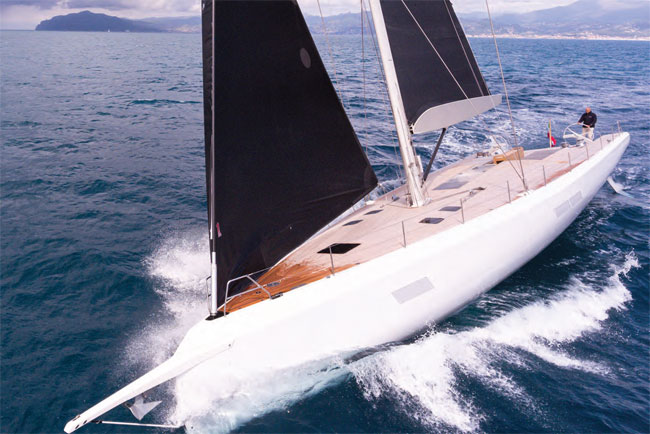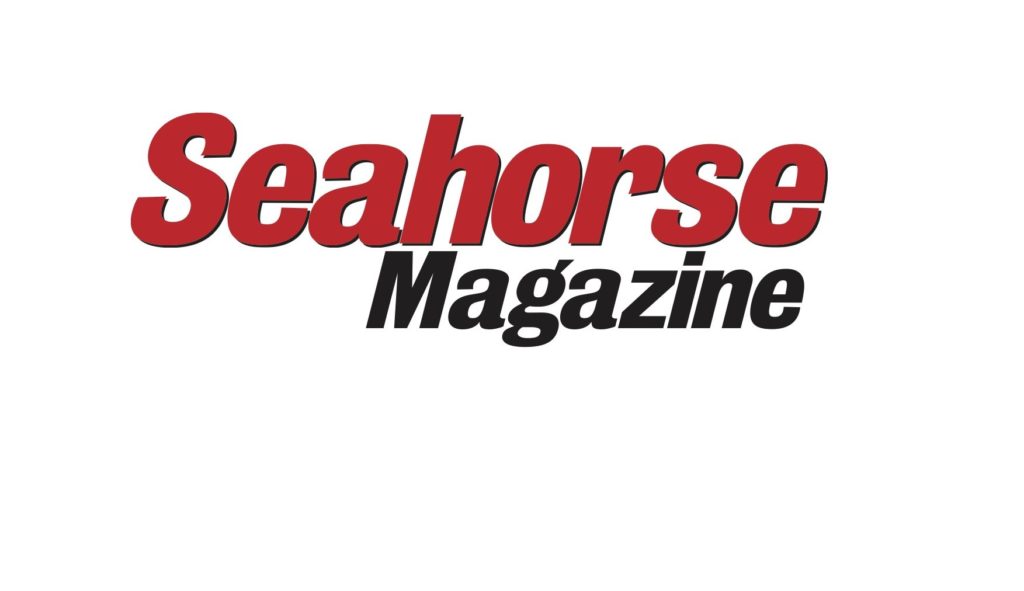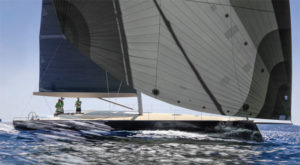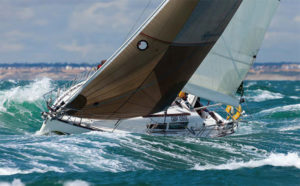PULITA – SEMPLICE – VELOCE

Karma… the fruit of the latest cooperation between luxury and performance yacht builders Maxi Dolphin and Wicklow-based designer Mark Mills really is just that
This design for a light, wide, and powerful performance cruiser with a large sailplan and a lifting keel prepared for established performance builders Maxi Dolphin shows how far modern raceboat design and construction can influence the next generation of high performance mile-eaters.
Headed by Luca Botter, the company has a lot of experience with this type of build, is located near the project manager, client, and interior designer Nauta in Milan, and understands the client’s vision: ‘pulita, semplice, veloce’ – clean, simple, fast. Moreover, they saw the opportunity for Karma to pave the way for further semi-custom builds of the MD75 design.
With the green light to proceed, work started immediately to outline the geometry with the boatyard’s technical office led by Giovanni Pizzatti, to produce a basis on which all the different contributors could begin working: design, engineering from AMS, builder, interior designer, spar builder Maxispar, and keel manufacturer Cariboni all had to contribute pieces of a complex puzzle. Every other facet of the project was Italian.
Once the major decisions on the interior and exterior layout had been made, construction began at the Maxi Dolphin facility near Brescia, where the experienced team quickly set up female moulds for the carbon/corecell hull and deck construction. This combination is becoming the most reliable and costeffective solution for performance designs of this type, bringing weight and stiffness gains complemented by a wider availability of builder friendly materials. It was the interior structure and components where higher tech solutions would pay the greatest dividends. Prepreg unidirectional caps were autoclaved and bonded to the longitudinal and transverse frames for ultimate stiffness, while all the interior parts are nomex cored for the lightest and most rigid possible solution. Another development is the advanced electronic system relying on digital switching, which significantly reduces cabling, and allows everything to be controlled from a simple mobile device. Once the interiors and systems were complete, the deck laid with teak, and the Cariboni lifting keel installed Karma was trucked to the coast in Lavagna, east of Genoa, ready for launch.
The project can be traced back to 2016 when Mark Mills was contacted by an experienced Italian project manager with a client looking for a very high-performance cruiser of around 75ft.
‘The client had grown up sailing high-performance dinghies and was an active kiteboarder. He wanted to translate his familiarity with the sea and high-performance sailing into a big boat, which would allow him to sail shorthanded around the Mediterranean, and have a nice family “apartment” to enjoy when he arrived in port. His demands were for very sleek and simple exterior styling, high performance for quick delivery to new locations, and a relaxed and casual interior to be developed with his friends at Nauta Design in Milan’, Mills explains.
‘The vision of the project manager was already well developed, so important features such as the generous beam, large tender storage and swept spreader rig with square top main and no backstay were pencilled in from the start,’ he says.
‘With a coherent brief already established, a light powerful hull shape was sketched with added volume in the ends to reflect its primarily offshore and offwind profile, which helps utilise the full accommodation length available. The difficulty was combining the extensive interior and amenity desired, with the performance necessary, demanding intelligent solutions to minimise weight and maximise performance,’ Mills adds.
Greater length is always more accommodating when it comes to headroom, allowing an aggressive low freeboard profile to feature a flush deck relieved only by a slight bulge over the saloon extending aft around the cockpit. This was faired fully into the deck, and was covered with unbroken teak, meaning from many angles it would still appear to be a completely flush deck. Its presence however created the low seatbacks outboard of the wide cockpit seats, helped raise the seats slightly for more headroom below, and provided some critical depth for items needing space above the internal headroom, such as the sprayhood arch, the sliding main hatch which must fit under it, and the underdeck halyard runs to the winches in front of the wheels. This search for headroom was to become one of the important threads of the design development process, to be expected whenever open, spacious interiors are competing with low freeboard and the need to recess vital features in the deck to remain “invisible”.
Although this was not primarily a design for racing, the importance of the latest generation of design tools for predicting not only speed and heel angle, but details such as rudder angle and leeway for foil optimisation make it a necessary component of any new design.
‘Our regular R&D partners KND/Sailing Performance ran the CFD and VPP studies looking into the areas we wanted to develop,’ says Mills. ‘As a high-performance cruiser with a lower priority on upwind performance than an inshore raceboat, the hull shape design focused on excellent downwind performance with more volume forward, especially above the waterline, ensuring a hull that responds better when pressed reaching and running. At the same time the volume at the stern needs to accommodate the aftward shift of the centre of gravity that is inevitable with a yacht bristling with amenities, without becoming so full that no light air performance remains.
‘Given this wide and relatively full hull aft, the draught limitation of a raised lifting keel, and the tender stowage aft, twin rudders were clearly indicated, and this was an opportunity to further refine the twin rudder solution.’
Another of the major contributors to Karma’s success is the widely respected Nauta Design office in Milan. Headed by partners Massimo Gino and Mario Pedol, this very experienced team started to develop the interior volume to deliver the casual, comfortable environment desired by the client. A design loop was quickly set up, negotiating how hull and deck geometry could be developed to better enable their interior vision, without compromising the performance and aesthetic standards set by the client. Among the many details addressed in this process were freeboard, deck camber, cockpit layout and hatch locations, to reach a tightly packaged solution.
Nauta’s layout is notable for its generous spaces throughout the boat, unified by lighting and simplicity. Bulkheads, sides and furniture are decorated in ‘lambris’ style: the lower part is made of oak with a ‘scratched’ effect, which conveys a feeling of warm comfort, while the upper part is made of white panels that enhance the cleanliness of the design. This philosophy is most strikingly evident in the large saloon, accessed from the comfortable, very wide and slightly sloping companionway, featuring a dining area with an eight-person table and a large lounge sofa that can comfortably seat four people.
For the exterior the preliminary drawings had shown a hard chine mated to a conventional sheer with a constant facet, but over a number of meetings with the project manager in Verona, the options of a faceted sheerline with lower bowsprit, a rounder turn of bilge, and a selection of hull window shapes were added to the list for consideration by the client, who chose the final combination of features seen in Karma.
Walking through Karma in Lavagna, Mills said, ‘I was struck by how clean and simple the final result is. The smooth uncluttered deck stretches unbroken the full length of the boat, yet all the controls are available in front of the wheel for easy sailing. Some clever details such as a disappearing flexible washboard and the main hatch/recessed full width sprayhood arch resolution, show off Maxi Dolphin’s detailing skills’.
With no runners the back of the boat is totally open providing a fabulous relaxing space, and with the transom door down the access to the water for kite or paddle boarding is made very easy. The simplified sail handling solutions make shorthanded performance easy, and with her stability and good manners the boat moves 75ft away from the need for a full crew to enjoy highspeed sailing.
The Nauta-designed interior in light neutral colours accentuated by orange highlights is a masterpiece of casual comfort, the low wide spaces inviting relaxation and enjoyment. With sea views and light from the large hull windows it feels bright and airy, establishing a benchmark for interior quality in a competitive niche of the performance cruiser market.
One of the benefits of the Maxi Dolphin methodology is that further semi-custom MD75 builds are relatively easy, allowing completely different interpretations of the same philosophy. Not just the fixed keel/ single backstay sailplan option but completely different interiors, deck and topside treatments, and cockpit geometry are possible, so perhaps next there will be a raised saloon version, or a higher-tech racing oriented development of this clean and simple speedster. Mills says, ‘it was a pleasure to be included in an otherwise exclusively Italian project, radiating as she does an Italian sense of style, grace, and performance’. PULITA – SEMPLICE – VELOCE.
Click here for more information on Max Dolphin »

This article was originally published in Seahorse Magazine and is kindly reproduced with their permission. To check their archive of free-to-view articles, please visit https://seahorsemagazine.com/archive/2020-archives
To subscribe to Seahorse at a discounted rate, please click here: http://bit.ly/SHMIN20











